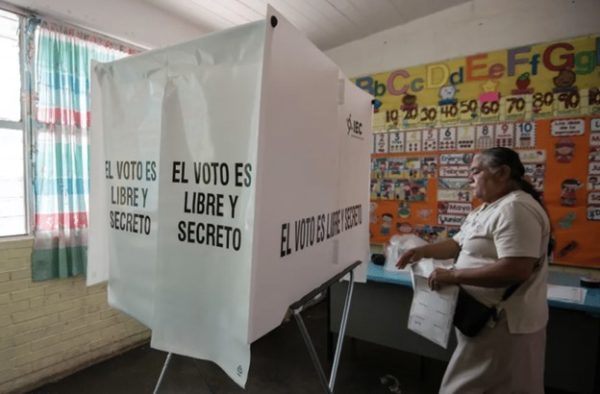Mexicans to Elect a New President this Sunday June 2nd
and the winner will be a woman

All polls favor the governing party candidate Claudia Sheinbaum, but the opposition candidate Xochitl Galvez claims there is a “hidden vote.”
By Maria Lourdes Pallais (Confidencial)
HAVANA TIMES – For the first time in Mexico’s political history, two women are vying for the presidential seat in an election. One leads the polls while the other, heading the main opposition parties, claims there is a “hidden vote” that will favor her on June 2nd.
“I feel the street, all the people need is to lose their fear of going out to vote, that’s all. The number is magical: if 63% (come out to vote) we will win the election, despite the government’s political control,” the opposition candidate said about the polls favoring her rival, whom she has called “Ice Lady,” “the candidate of lies,” and “narco-candidate.”

The campaign has taken place in an environment with high levels of polarization, perhaps like never before in Mexico, fueled almost exclusively by insults (corrupt, cynical, enablers, conservatives, hypocrites, opportunists) thrown out daily by President Andres Manuel Lopez Obrador (AMLO) in his morning press conferences against those he considers his adversaries (journalists, analysts, politicians, businesspeople).
There are two coalitions setting the tone for this election (“referendum or plebiscite,” the still-president prefers to call it). The official “Keep Making History” of Morena, with the stoic and disciplined scientist Claudia Sheinbaum at the forefront, and the opposition alliance “Strength and Heart for Mexico,” with the charismatic engineer Xochitl Galvez, a politician, businesswoman, and computer engineer supported by the traditional parties (PRI, PAN, and PRD).
There is also a third political group in the race, Movimiento Ciudadano (MC), whose presidential candidate is Jorge Alvarez Maynez. This party recently suffered a tragedy where nine people died and 189 were injured in a campaign event in Nuevo Leon. MC, which holds around 10% of the preferences in the polls, is called a “strikebreaker” by many in the opposition because its existence takes votes away from Galvez.
It is also the largest election in Mexico’s history, covering over 19,000 positions, including 128 senate seats, 500 federal legislators, nine governorships, and the mayor of Mexico City.
Claudia Sheinbaum’s Advantage
The polls, which are many and not all reliable, show a significant difference between the candidacies. This is pointed out by Polls Oraculus MX (Polls of Polls), a platform that analyzes both the information from polling houses and their historical performance in relation to official results in past elections.
Based on this survey’s results, Claudia Sheinbaum leads the June 2nd race with a 22-point advantage over her closest competitor, Xochitl Galvez. The former mayor of Mexico City has 56% of the electoral preferences, while Galvez is in second place with 34% of the voting intentions. It is worth noting that Sheinbaum has seen a decline in her electoral preferences throughout the campaign, which started with 66% of the voting intentions.
It should also be noted that, although Sheinbaum is better known than Galvez, the trend in her favor is an inheritance by osmosis from the president, who is ultimately the source of that sympathy and loyalty. No one disputes that Lopez Obrador, months before the end of his six-year term in Mexico, is one of the world’s most popular presidents. “Claudia Sheinbaum’s strength is derived from AMLO,” analyst Rene Delgado told CONFIDENCIAL.
A major contradiction arises in that the official coalition, whose candidate has announced a more ambitious plan than AMLO’s in public education but intends to be the “second floor” of the so-called “Fourth Transformation” (a strategy devised by AMLO that leaves Sheinbaum as the heir), is the one most concerned about taking measures against the supposed “technical fraud” that the opposition is allegedly planning against the “State election.”
Equally contradictory is that Lopez Obrador has spent much of the last few days campaigning, violating electoral laws that prevent him from addressing issues related to the race in his morning press conferences. If he is so confident in his candidate’s victory, why has he intervened so insistently in the electoral campaign despite being prohibited by the National Electoral Institute?
“We could be facing a government and Morena party strategy to not recognize opposition victories in municipalities, districts, states, or in the presidency of Mexico,” said Jorge Alcocer Villanueva, founder of the magazine Voz y Voto, to CONFIDENCIAL.
“Another hypothesis is that the allegations of ‘fraud’ are intended to mobilize voters in ‘defense’ of the vote. In any case, it is a terrible message to citizens” because “it can discourage participation at the polls. It is usually the opposition that warns of fraud. In this case, it is the Government and its party sowing distrust,” the expert adds.
The Path of the “4T”
Despite the polls pointing to Sheinbaum as the likely winner and her own assertion (although she later said it was a joke) that the June 2nd election is “just a formality” for her, even if she wins, the path to continue the Fourth Transformation (4T) of Mexico’s public life needs much more than her.
Obtaining a qualified majority in Congress, for example, is vital for the continuity plans of the “4T” and its allies, as AMLO has left 18 constitutional reforms and two legal ones pending. We will have to see how many crossover votes are recorded on election day and if, indeed, there will be a vote that could affect the approval of these issues, assuming Sheinbaum wins the contest.
For a candidate who seeks to maintain the goal of “The poor first,” the challenges are immense.
In Mexico, the lag in well-being and existing poverty is enormous, and AMLO’s social programs have left the budget at its limit. Although Sheinbaum denies that the country is militarized, she has promised to maintain Lopez Obrador’s policy and leave many civilian functions in the Army. AMLO has left Sheinbaum several other tasks: continuing the policy of attending to young people with social programs so they are not seduced by the cartels and ensuring that the poorest people are guaranteed the right to work and a fair salary.
With the countryside as the second floor of the “4T,” Sheinbaum’s team will have to stop highway robberies, modernize irrigation, achieve food sovereignty, and rural development while drug cartels seem to have gained more control than before in several aspects of everyday Mexican life.
According to a recent report by The Washington Post, even the sale of tortillas has been dominated. The National Tortilla Council estimates that at least 15% of the country’s tortillerias are being extorted. In Sinaloa, armed groups have infiltrated the public water system, and in some cases, armed groups buy and sell corn.
Meanwhile, a US State Department survey shows that 39% of Mexicans are considering migrating to the United States, a considerable increase since 2022. According to Lantia Consultores, a company specializing in the analysis of violence, organized crime, and security policies, there are now two criminal cartels, 87 regional mafias, and 586 gangs.
The debates between the three candidates have not offered many proposals, both due to the rigid format and because, especially in the third and final debate, the attacks between the two leading candidates outweighed proposals on the country’s most pressing issues, such as violence, the migration crisis, crime, organized crime, and the conflict over the division of powers.
The “Pink Wave” of Xochitl Galvez
One of the debates between the three presidential candidates took place after a massive rally in favor of the opposition candidate in Mexico City’s Zocalo Plaza. According to official figures, 95,000 people attended the so-called “pink wave” (which seeks to make democracy visible with that color), but organizers claimed there were 350,000 people.
On this occasion, the National Coordinator of Education Workers, a contingent of teachers from the dissident section of the teachers’ union, remained at the march in a provocative attitude while the National Palace finally raised the flag at 10 am (usually done at 6 am). The order came from a judge after the flagpole in the capital’s Zócalo Plaza was empty during the last two “pink wave” rallies, something that has not happened with rallies led by the governing party, Morena. But this time, the president committed to keeping the national flag raised, stating that “the flag belongs to all Mexicans, even the traitors to the homeland.”
While Lopez Obrador —and thus Sheinbaum— insist on their parallel reality with their other data (“Mexico is a peaceful country”) and addressing the structural causes of violence, there is evidence that it has only increased in the last five years. His government claims a reduction of up to 20% in homicides, but his administration is already the deadliest in the country’s history, with 171,085 homicides between December 1, 2018, and December 2023.
What worries observers in these elections is that the result may be very close. There could be surprises next Sunday shortly after the polls close if “the difference between the winner and the second place is single-digit,” warns Alcocer.
A complex campaign has ended in a violent and polarized environment that was anything but peaceful and has left several red flags. This is how analyst Rene Delgado describes the end of this long and tumultuous campaign: “With the electoral trend in favor of Claudia Sheinbaum and Morena, with growing polarization and under the threat of violence and presidential prominence bordering on undue intervention in the process,” he told CONFIDENCIAL.
The post-election conflict will depend on the gap between the winner and the loser, at least in the presidential election, which does not mean that the other elections, which are many, are not important in defining Mexico’s future. What is clear is that for the first time, the president will be a woman.





